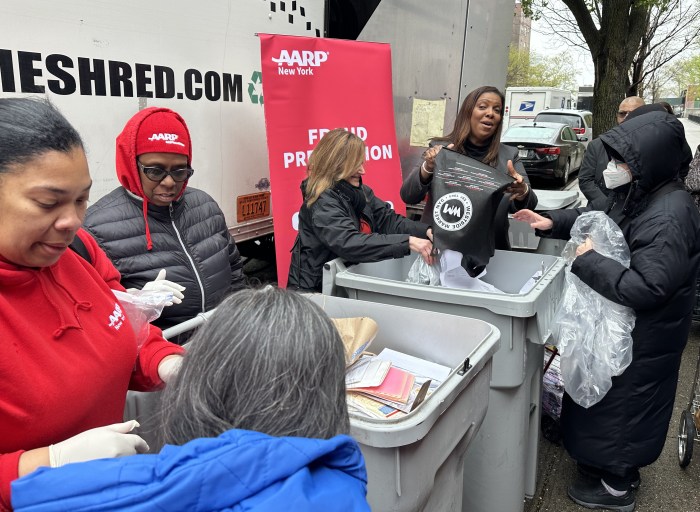The New York City Housing Authority has misled the federal government and public about the scope of lead paint in its portfolio, the number of children with concerning blood lead levels and how violations of housing regulations have contributed to the crisis, according to court documents filed by federal prosecutors.
Geoffrey Berman, the U.S. attorney for the Southern District of New York, said his team filed a civil complaint and proposed settlement agreement Monday with the goal of reforming a host of NYCHA practices. The 80-page complaint accuses NYCHA of deceiving inspectors about lead paint hazards and working to mask leaks, broken elevators and other dilapidated conditions the authority has failed to root out since 2010.
Berman said he was optimistic about the proposed settlement — which city officials have signed and which calls for appointing a monitor to oversee NYCHA’s turnaround — will improve life for the authority’s 400,000 residents. But he would not rule out the possibility of pursuing criminal charges.
“NYCHA put thousands of NYCHA families at risk,” Berman said. “These conditions are an assault — they’re an assault on the health, safety and dignity of hardworking and rent-paying NYCHA residents. And as is often the case, where there are violations, there is a cover-up.”
Based on an investigation launched in 2016, the Southern District said in court documents that NYCHA did not abide by a requirement to inform the U.S. Department of Housing and Urban Development about children under 6 who have high enough blood lead levels to mandate that hazards be contained in their homes.
At least 19 lead-poisoned children were exposed to deteriorating lead paint in their NYCHA apartments between 2010 and 2016, according to the complaint.
The city’s Health Department informed NYCHA between 2010 and 2015 that 68 children living in NYCHA apartments with confirmed paint hazards had been reported to have blood lead levels that are high enough to be a risk for brain function deficits, the complaint said.
Because the city’s threshold for reporting blood lead levels differs from the federal government’s, NYCHA was not automatically obligated to report all 68 cases. But the complaint said NYCHA took no steps to determine which, if any, should have been referred to HUD.
The complaint concludes there is “every reason to believe the true number of children with lead poisoning is materially higher,” because the city’s Health Department has received reports from medical professionals indicating “many hundreds” of additional children living in NYCHA developments have elevated blood lead levels — but the department has only been able to investigate a fraction of the apartments.
Even when the Health Department gets inside, the complaint said NYCHA’s official policy is to contest all of the department’s orders to address lead paint hazards in apartments. As a result, just 19 such orders were finalized between 2010 and 2016, the complaint said.
According to NYCHA’s own documents, lead paint is present in more than half of NYCHA developments and inside apartments in 92 developments, the complaint said.
NYCHA did not conduct most of the biennial lead paint risk assessments required in these developments since 2010, according to the settlement. The authority also failed to do required visual scans for peeling paint and other potential dangers for years in apartments that may contain lead and in apartments where children under 6 live, the complaint said.
NYCHA falsely indicated they were abiding by lead laws in formal HUD documents and misled the public at meetings and in a news release, the complaint said.
“The problems at NYCHA reflect management dysfunction and organizational failure, including a culture where spin is often rewarded and accountability often does not exist,” the complaint said.
Up until last summer, NYCHA included a “cover-up ‘how-to’” in their training materials, prosecutors said. The complaint detailed NYCHA practices of shutting off water supply to conceal leaks, plugging holes with newspapers and cork, and building false walls to conceal dilapidated rooms ahead of federal inspections. NYCHA did not make it a practice to inform the workforce — which was largely untrained on how to safely handle lead paint — that they were being dispatched to conduct repairs that may put them in contact with the toxin, the complaint said.
Federal prosecutors said NYCHA routinely indicated it was meeting requirements to provide decent, safe and sanitary housing, while internal NYCHA documents show nearly 300 complaints of 100-square-foot swathes of mold, 80 percent of tenants losing heat this winter and exterminators spraying properties with water due to supply shortages.
Once a judge approves the agreement, NYCHA would have 150 days to notify residents they are living in apartments that contain lead or in a building where lead paint has been detected in common areas, according to the proposed settlement.
The court would also appoint a monitor to ensure NYCHA does not make false or misleading statements to the federal government and abides by housing regulations. Initially, the monitor would submit quarterly reports with objective data showing how much progress NYCHA has made.
The Southern District said the settlement would direct about $4 billion from various sources to capital improvements at NYCHA during the first four years. The city would be expected to budget at least $2 billion for NYCHA over the next five years, and may be on the hook for more, according to Mayor Bill de Blasio.
“However, given the enormity of NYCHA’s capital needs — projected to be at least $25 billion — the funding will have an important but modest overall impact and will not make up for more than a decade of underinvestment,” Maria Doulis, vice president of the Citizens Budget Commission, wrote in an email. “The decree acknowledges that in order to effectively address the serious issues it identifies, substantial changes are needed in NYCHA’s organization and management; in its regulatory burdens and procurement and construction restrictions; and in its union workrules and staffing structure.”
Gov. Andrew Cuomo’s administration announced it was suspending plans to appoint an emergency manger of NYCHA.
Speaking to reporters Monday, de Blasio said he was hopeful the settlement would steer NYCHA toward more stable days.
“When I ran for this office, I did not run for this office to continue a broken status quo. It will be my sacred mission to fix the reality in public housing, and set the stage for additional improvements in the years after I have completed my term in office,” de Blasio said. “So you want an apology? I apologize, and I want to hear everyone else apologize, but more importantly, I want to fix the problem.”
Former Mayor Michael Bloomberg, who left office in 2013, declined to comment through a spokesman.
With Alison Fox

















